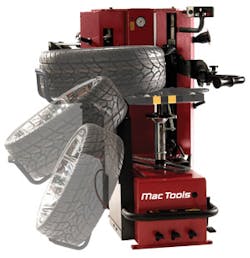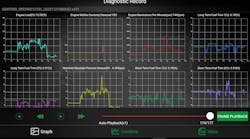Manufacturers of tire service equipment see a lot of change in their industry, from tire types and sizes to nitrogen-filled. Their focus is shifting to faster, safer machines capable of changing tires on larger rims due to recent trends — some shops are servicing rims as large as 36". To keep up, smaller shops as well as chain retail shops are switching out their tire service equipment.
Matching shop needs
Paul Zarlengo, project manager for shop equipment at Mac Tools, said that maximum outside tire diameter, maximum rim width, outside clamping diameter range and the inside clamping diameter range are the four general criteria involved when assessing tire changers. When a tech knows what kind of rim and tire they will be dealing with most, these areas are key in purchase decisions.
When selecting a tire changer, shop owners need to review the sizes of tires and rims coming through their shop.
"For example, common small size tires are motorcycles … down to golf cart tires," Zarlengo said. "Large tires range from 18-wheeler OTR tires up to large agriculture tires like those on tractors and combines."
Another thing buyers look for is the bead-breaking force, which determines the strength needed for popping tires off the rims. According to Zarlengo, prices for this equipment can run anywhere from about $3,000 to $6,000.
Manufacturers are also seeking ways to improve hydraulics in tire changers, for more efficient service.
"Older hydraulic tire-changing equipment consumes much more air than the machines of today," said Ryan Lang, commercial portfolio manager of Air Solutions and Ingersoll Rand Industrial Technologies.
"In some cases, units today are using about 20 percent of the air consumption" as compared with machines using older technology, he said.
Run-flats and PAX
The PAX tire and its sister, the "run-flat" tire, are recent developments in the industry. Key elements of the Michelin-certified PAX system include special wheels with unique tire bead locks, and a solid insert that supports a share of the vehicle's weight to continue rolling when tire pressure drops.
About two years ago, Honda put PAX tires as an option on their Odyssey minivan; Toyota followed suit with the Sienna.
But when the OEMs made the PAX available, "they didn't consider that the tire-changer industry hadn't really caught up with the PAX style tire designs," Zarlengo said.
"Whenever they had a flat, or needed to change a tire, the OEMs had to ship [mounted] tires and rims. It became a bit of a nightmare.
"Now the tire changer industry has caught up, but it entails a very specialized type of changer. PAX changers can change other tires as well, but they are uniquely designed to deal with PAX tires."
Tractor-trailers are also impacting the frontier of tire technology.
"The Super-single tire [designed for 18-wheel vehicles] is not two tires, but one big wide one," Zarlengo said. "This new over-the-road tire design is still very young, but a few fleet companies are experimenting with it."
According to Zarlengo, changers designed particularly for Super-singles would also be compatible with large tires for agriculture equipment, and the equipment would cost about $20,000.
Up in the air about nitrogen
Lang feels that more companies are recognizing the benefits of nitrogen, and maintains that it is becoming common in the vehicle market.
"People were skeptical [at first], they thought it was snake oil," Lang said. "Through studies driven by independent third groups, our claims of
tire life and fuel economy improvements have been validated over and over."
Nitrogen is regularly used in the tires of 747s and NASCAR cars and NHRA drag racers — in short, extreme environments where every advantage is needed to keep tires cool and stable. Should nitrogen inflation systems make a successful leap between markets, manufacturers are creating upgrade kits which will make their machines compatible with nitrogen systems.
"What that means is, whenever they fill a tire, they have a bypass that runs nitrogen to the tire. What they're using for their hydraulics and for the ballast tank is normal air," said Lang.
Several major tire dealer chains are adopting nitrogen tire technology, so be sure to check in on those shops regularly where initial knowledge
is above the curve. Family-owned shops and smaller chains are slow to investigate.
The jury is out
"There hasn't been definitive evidence that says there's an absolute benefit in normal car, passenger or light truck duty usage," Zarlengo said. "We do know for a fact that there is a lot of benefit in extreme duty places.
"The jury, in my opinion, is the manufacturers of the tires themselves. They have to say, 'Yes, I want everyone to put nitrogen in their tires.' "
Nitrogen feed systems can have anywhere from one to five filters, and flow rates ranging from 1-2 to 5-6 cfm (larger systems run at about 6 cfm, and can cost as much as $20,000).
"Independent shops will buy the systems if they feel there's some benefit to it," said Zarlengo. But many small shops feel they simply can't afford to invest in something without solid proof of a return. (The smallest nitrogen feed systems run about $3,699 for a 1 cfm, 6-gallon, 116-psi machine, making it a hard sell.)
Time will only tell if nitrogen systems will find their way into the mainstream.
"Large Fortune 500 companies are realizing the benefits nitrogen can provide to the environment and enjoy having that green image," said Lang "so other companies are trending towards being environmentally-friendly, too."
"There are people out there who think, 'I just don't have the money to buy this right now.' But what [mobile distributors] need to realize when selling this equipment is that educating the consumer is still number one. It's not an easy sell; it's still an uphill battle."
It remains to be seen whether and when a turning point will come. But with talk about benefits like fewer emissions, improved gas mileage and longer tire wear, it seems worth a closer look.
Sources:
Paul Zarlengo, Mac Tools.
www.mactools.com
Ryan Lang, Air Solutions and Ingersoll Rand
Industrial Technologies.
www.ingersollrand.com


